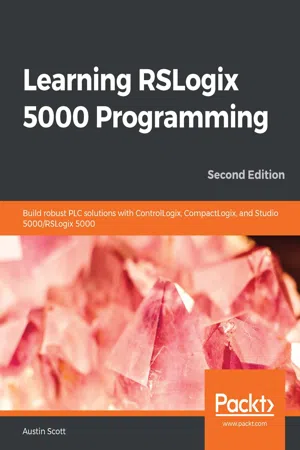
Learning RSLogix 5000 Programming
Build robust PLC solutions with ControlLogix, CompactLogix, and Studio 5000/RSLogix 5000, 2nd Edition
- 384 pages
- English
- ePUB (mobile friendly)
- Available on iOS & Android
Learning RSLogix 5000 Programming
Build robust PLC solutions with ControlLogix, CompactLogix, and Studio 5000/RSLogix 5000, 2nd Edition
About this book
Get to grips with the Logix platform, Rockwell Automation terminologies, and the online resources available in the Literature Library
Key Features
- Build real-world solutions using ControlLogix, CompactLogix, and RSLogix 5000/Studio 5000
- Understand the different controllers and form factors offered by the ControlLogix and CompactLogix platforms
- Explore the latest changes in the Studio 5000 Automation Engineering and Design software suite
Book Description
Understanding programmable logic controller (PLC) programming with Rockwell Software's Logix Designer and the Studio 5000 platform, which includes ControlLogix, CompactLogix, and SoftLogix, is key to building robust PLC solutions. RSLogix 5000/Studio 5000's Logix Designer are user-friendly IEC 61131-3-compliant interfaces for programming the current generation of Rockwell Automation Controllers using Ladder Diagram (LD), Function Block Diagram (FBD), Structured Text (ST), and Sequential Function Chart (SFC).
This second edition of Learning RSLogix 5000 Programming guides you through the technicalities and comes packed with the latest features of Studio 5000, industrial networking fundamentals, and industrial cybersecurity best practices. You'll go through the essential hardware and software components of Logix, before learning all about the new L8 processor model and the latest Studio 5000 architecture to build effective integrated solutions. Entirely new for this edition, you'll discover a chapter on cybersecurity concepts with RSLogix 5000. The book even gets you hands-on with building a robot bartender control system from start to finish.
By the end of this Logix 5000 book, you'll have a clear understanding of the capabilities of the Logix platform and be able to confidently navigate Rockwell Automation Literature Library resources.
What you will learn
- Gain insights into Rockwell Automation and the evolution of the Logix platform
- Find out the key platform changes in Studio 5000 and Logix Designer
- Explore a variety of ControlLogix and CompactLogix controllers
- Understand the Rockwell Automation industrial networking fundamentals
- Implement cybersecurity best practices using Rockwell Automation technologies
- Discover the key considerations for engineering a Rockwell Automation solution
Who this book is for
If you're a PLC programmer, an electrician, an instrumentation technician, or an automation professional with basic PLC programming knowledge, but no knowledge of RSLogix 5000, this RSLogix 5000 book is for you. You'll also find the book useful if you're already familiar with automation and want to learn about RSLogix 5000 software in a short time span.
Frequently asked questions
- Essential is ideal for learners and professionals who enjoy exploring a wide range of subjects. Access the Essential Library with 800,000+ trusted titles and best-sellers across business, personal growth, and the humanities. Includes unlimited reading time and Standard Read Aloud voice.
- Complete: Perfect for advanced learners and researchers needing full, unrestricted access. Unlock 1.4M+ books across hundreds of subjects, including academic and specialized titles. The Complete Plan also includes advanced features like Premium Read Aloud and Research Assistant.
Please note we cannot support devices running on iOS 13 and Android 7 or earlier. Learn more about using the app.
Information
- Chapter 1, The History of the Rockwell Automation Technologies
- Chapter 2, Understanding ControlLogix
- Chapter 3, Understanding CompactLogix
- Chapter 4, Understanding Softlogix
- Chapter 5, Understanding Logix Emulate 5000
- Controlling equipment with water, air, and power
- A brief history of Rockwell Automation
- Understanding Integrated Architecture
Controlling equipment with water, air, and power

The rise of pneumatics

Understanding electric relay logic
- Competitively priced with a traditional relay logic system
- Leveraging a solid-state system that is flexible, such as a computer
- Programmed in a manner that aligns with accepted relay ladder engineering diagrams
- Robust enough to work in industrial environments where they would be exposed to dirt, moisture, electromagnetism, and vibration
- Modular and expandable to support a wide range of process sizes and types
A brief history of Rockwell Automation
Program Data Quantizer II and the Programmable Matrix Controller
Table of contents
- Title Page
- Copyright and Credits
- Dedication
- About Packt
- Contributors
- Preface
- Section 1: Introduction to RSLogix
- The History of Rockwell Automation Technologies
- Understanding ControlLogix
- Understanding CompactLogix
- Understanding SoftLogix
- Understanding Logix Emulate 5000
- Section 2: Logix Programming Basics
- Industrial Network Communications
- Configuring Logix Modules
- Writing Ladder Logic
- Writing Function Block
- Writing Structured Text
- Building Sequential Function Charts
- Section 3: Advanced Logix Programming
- Using Tasks and Programs for Project Organization
- Faults and Troubleshooting in Logix
- Understanding Cybersecurity Practices in Logix
- Building a Robot Bartender in Logix
- Assessments
- Other Book You May Enjoy